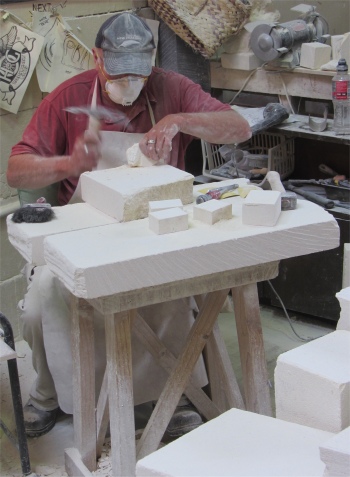 The Taciturn Limestone Sculptor |
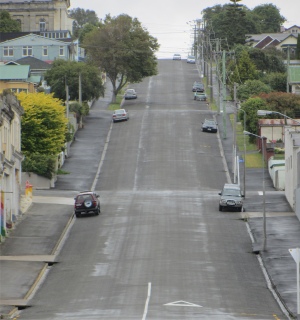 Oamaru Has Streets Like Those in San Francisco |
A cursory glance revealing what appeared to be whitewashed buildings. Further study revealed I couldn't be further from the truth. In the latter half of the 19th century, the town served as a commercial hub for gold-rush prospectors. Then, the growth of timber, farming and quarrying industries boosted the prosperity of the town, and the port became an immigration centre for a while. It was this prosperous phase combined with the discovery that the local limestone outcrops could easily be carved, that led to architects creating a settlement labelled as New Zealand's best-built town; "The Whitestone City".
The prime ingredient for Oamaru's architectural wonders was whitestone, a stone easily worked with metal tools when freshly quarried, but hardened when exposed to the elements. Wandering around the Harbour and Tyne Street district, I feasted my eyes on the imposing buildings that graced the town. Harbour Street had an old rail track running down it, a reminder of the days when the town thrived as a busy port. Here, in the town's original commercial quarter, was an art ideal, a beautiful balance between unity and diversity: a diverse range of classic architectural styles ranging from Gothic revival, through neoclassical Italianate and Venetian palazzo, to Victorian, all unified in creamy white Oamaru stone. Oamaru was indeed a small well preserved historical town, the historic precinct serving as New Zealand's most complete Victorian Streetscape. The Oamaru Whitestone Civic Trust was working to restore the Precinct. While the historic area sometimes gave the impression of being deserted, several small businesses operate, which complement the Victorian Town Work theme. The Criterion Hotel, which was closed in 1905 when prohibition was brought in, had been fully restored to a working Victorian style pub. Nowadays The Criterion was renowned for its authentic beers and fine pork pies, in the tradition of the Victorian era. Sadly, it was closed on Tuesdays, and today was Tuesday. Coffee houses, secondhand book stores, craft shops, antique shops, art galleries and small museums made this an ideal place to chill out after the rugged outdoors Aoraki Mount Cook experience.
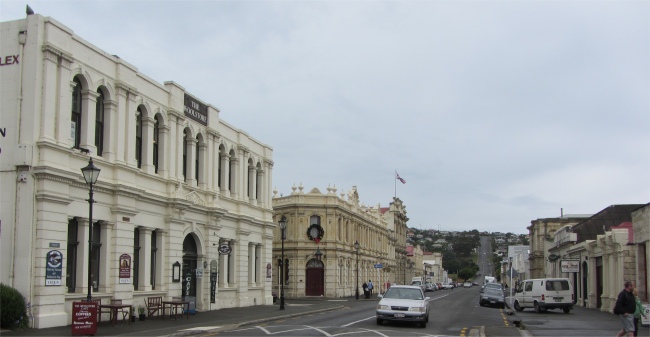 Tyne Street |
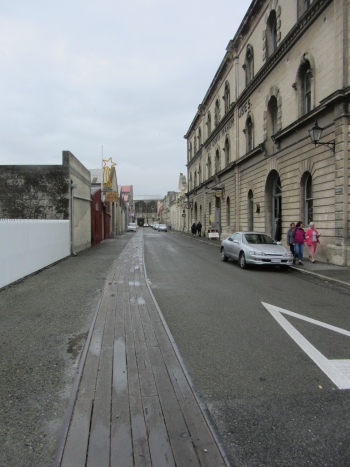 Harbour Street |
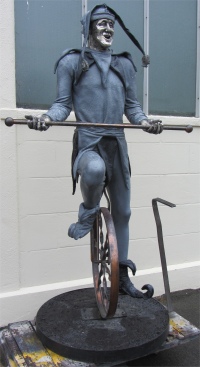 A Jester in Tyne Street |
He had some gripes about New Zealand, he reckoned half the nation were hardworking, and half were totally laid back, so much so that he labelled them slackers. As a for instance, in Oamaru's busiest two weeks, a lot of cafes close down while staff have a holiday, then the same cafes complain that they have not made much money over the year. I didn't fall into the trap of arguing, I wanted to be off soon.
A few doors down was a stone mason first sawing a block of limestone, and then sculpting it with a hammer, then filing it, drilled a few holes in it, and then sanded it. The fellow had a mask on to keep the dust out of his lungs. A sign behind him quoted the common questions people ask, and provided the answers. This guy did not want to chat, unless I was a paying customer.
 Examples of Oamaru Limestone Buildings |
On Tyne Street the Union Jack fluttered, and Victoriana lived on. I did pop into the town's art gallery, and saw an impressive exhibition by the New Zealand artist Rita Angus, who by accounts had lived a self-imposed tortured lifestyle, which was often reflected in her work. Quite often she would feel the need to deprive herself of something when beginning a new piece of art, it could be sleep, food or whatever deprivation she felt necessary, which did land her in hospital at one time through starvation. Her portraits were excellent, her landscapes didn't do a lot for me.
 Moeraki Boulders |
Continuing my beeline south along the Pacific coast, I pulled in to Moeraki to view the Moeraki Boulders, almost unique in the world. According to Maori tradition, the boulders were gourds and calabashes, which were traditional Maori food, washed from the great voyaging canoe Araiteuru when it was wrecked upon landfall in New Zealand, some 1000 years ago. Geology painted a different story. Emerging from the cliff, as if being born from the earth, the boulders were septerian concretions formed some 65 million years ago. Crystallisation of calcium and carbonates around charged particles in muddy undersea sediments gradually formed the boulders in a process taking as long as four million years. The soft mudstone containing the boulders was raised from the sea bed around 15 million years ago, and sea erosion of the cliff was exposing the erosion-resistant boulders. Strewn along the windswept beach like giant turtle eggs, these beautiful spherical stones, some up to well over a metre in circumference, had tumbled down onto the beach and were slowly disappearing into the sand and sea.
 Yet More Moeraki Boulders Being Bashed by the Pacific Ocean |
It was late when I arrived in the city, so I decided to forego exploration until the morning.
